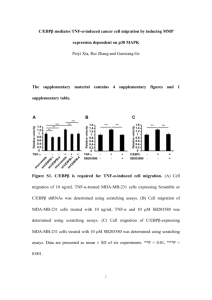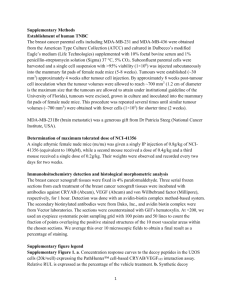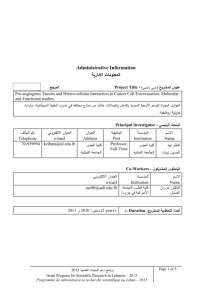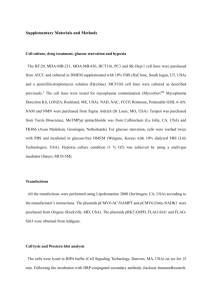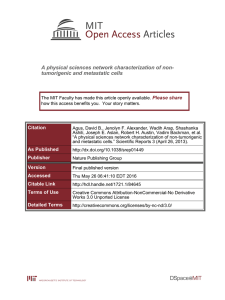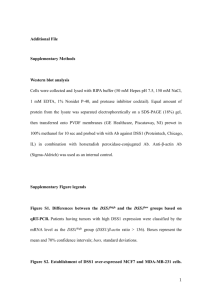VNandakumar_ASU_3Dcytometry_Nov2010
advertisement
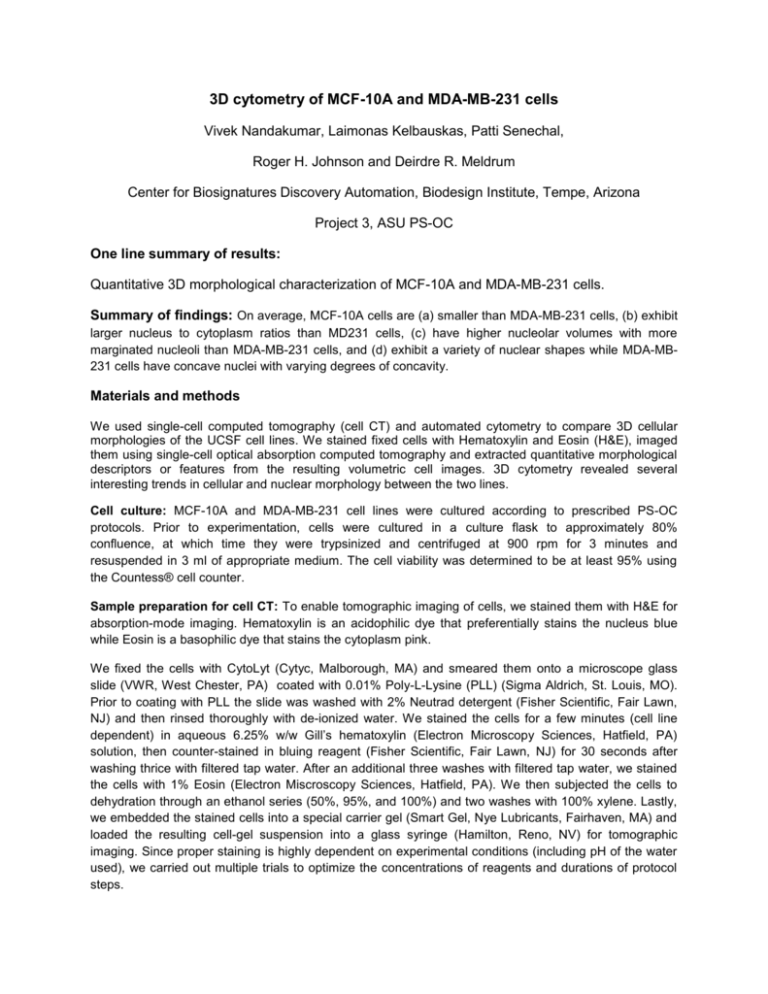
3D cytometry of MCF-10A and MDA-MB-231 cells Vivek Nandakumar, Laimonas Kelbauskas, Patti Senechal, Roger H. Johnson and Deirdre R. Meldrum Center for Biosignatures Discovery Automation, Biodesign Institute, Tempe, Arizona Project 3, ASU PS-OC One line summary of results: Quantitative 3D morphological characterization of MCF-10A and MDA-MB-231 cells. Summary of findings: On average, MCF-10A cells are (a) smaller than MDA-MB-231 cells, (b) exhibit larger nucleus to cytoplasm ratios than MD231 cells, (c) have higher nucleolar volumes with more marginated nucleoli than MDA-MB-231 cells, and (d) exhibit a variety of nuclear shapes while MDA-MB231 cells have concave nuclei with varying degrees of concavity. Materials and methods We used single-cell computed tomography (cell CT) and automated cytometry to compare 3D cellular morphologies of the UCSF cell lines. We stained fixed cells with Hematoxylin and Eosin (H&E), imaged them using single-cell optical absorption computed tomography and extracted quantitative morphological descriptors or features from the resulting volumetric cell images. 3D cytometry revealed several interesting trends in cellular and nuclear morphology between the two lines. Cell culture: MCF-10A and MDA-MB-231 cell lines were cultured according to prescribed PS-OC protocols. Prior to experimentation, cells were cultured in a culture flask to approximately 80% confluence, at which time they were trypsinized and centrifuged at 900 rpm for 3 minutes and resuspended in 3 ml of appropriate medium. The cell viability was determined to be at least 95% using the Countess® cell counter. Sample preparation for cell CT: To enable tomographic imaging of cells, we stained them with H&E for absorption-mode imaging. Hematoxylin is an acidophilic dye that preferentially stains the nucleus blue while Eosin is a basophilic dye that stains the cytoplasm pink. We fixed the cells with CytoLyt (Cytyc, Malborough, MA) and smeared them onto a microscope glass slide (VWR, West Chester, PA) coated with 0.01% Poly-L-Lysine (PLL) (Sigma Aldrich, St. Louis, MO). Prior to coating with PLL the slide was washed with 2% Neutrad detergent (Fisher Scientific, Fair Lawn, NJ) and then rinsed thoroughly with de-ionized water. We stained the cells for a few minutes (cell line dependent) in aqueous 6.25% w/w Gill’s hematoxylin (Electron Microscopy Sciences, Hatfield, PA) solution, then counter-stained in bluing reagent (Fisher Scientific, Fair Lawn, NJ) for 30 seconds after washing thrice with filtered tap water. After an additional three washes with filtered tap water, we stained the cells with 1% Eosin (Electron Miscroscopy Sciences, Hatfield, PA). We then subjected the cells to dehydration through an ethanol series (50%, 95%, and 100%) and two washes with 100% xylene. Lastly, we embedded the stained cells into a special carrier gel (Smart Gel, Nye Lubricants, Fairhaven, MA) and loaded the resulting cell-gel suspension into a glass syringe (Hamilton, Reno, NV) for tomographic imaging. Since proper staining is highly dependent on experimental conditions (including pH of the water used), we carried out multiple trials to optimize the concentrations of reagents and durations of protocol steps. cell CT: We performed optical tomographic imaging of stained, individual cells using a computed tomography (CT) instrument (VisionGate, Gig Harbor, WA). The cell CT instrument provides isotropic spatial resolution of 350 nm. We imaged the cells sequentially by flowing the carrier gel through a rotating glass capillary. For each cell, we generated a volumetric image by acquiring 500 projection images taken at angular intervals of 0.72 degrees around the cell and subjecting these projection images to mathematical reconstruction algorithms. Prior to reconstruction, we de-noised and aligned the projection images to remove pattern noise artifacts and to compensate for mechanical jitter and runout of the capillary, respectively. We imaged one hundred cells from each cell line and used the generated volumetric images for morphometric analyses. 3D cytometry: We quantified cell and nuclear structure with robust 3D image processing algorithms applied to the cell image data. We denoised the image, segmented the volumes of interest (VOIs) including the cell, the nucleus, nuclear compartments and the nuclear DNA, and computed morphological and textural descriptors (or features) from the segmented VOIs. These methods are detailed in (1). To ensure accuracy in feature computation, the segmented VOIs were cross-validated by a skilled operator. Subsequently, we computed histograms and statistically characterized distributions of readily comprehendible 3D morphometric feature data and to reveal quantitative differences between corresponding features in the two cell lines. Results Our observations on the two cell types based on 3D morphological analysis of our imagery are detailed below. Statistical data supporting these observations is detailed in table 1. MCF-10A cells are smaller than MDA-MB-231 cells MCF-10A cells exhibit a higher NC ratio than MDA-MB-231 cells MDA-MB-231 nuclei are farther away from a spherical shape than MCF-10A nuclei MCF-10A nuclei have a relatively higher volume of nucleoli that are more marginated toward the nuclear periphery than nucleoli in MDA-MB-231 nuclei MCF-10A nuclei have relatively higher fractions of low and high density objects but MDA-231 nuclei have a relatively higher fraction of medium density objects Table 1: Descriptive statistics of select morphological features Feature description Statistics of computed features (N=100) Mean Cell volume (µm3) Nuclear volume (µm3) NC ratio Nuclear sphericity Total nucleolar volume (µm3) Nucleolar proximity(µm) Low nuclear density fraction Medium nuclear density fraction High nuclear density fraction MCF-10A Standard deviation Mean MDA-MB-231 Standard deviation 2494 540 801 179 2928 553 748 170 0.30 1.39 11.18 0.11 0.15 6.51 0.24 1.42 9.77 0.06 0.15 5.85 2.87 0.67 2.55 0.83 0.15 0.02 0.14 0.02 0.67 0.05 0.70 0.05 0.17 0.03 0.16 0.03 MCF-10A nuclei exhibit diverse morphologies while MDA-MB-231 nuclei are consistently concave but with varying degrees of concavity. MCF-10A nuclear shapes MDA-MB-231 nuclear shapes Conclusions Our inferences based on the current dataset point towards interesting morphological traits exhibited by these two cell types. MCF-10A cells are (a) smaller than MDA-MB-231 cells, (b) exhibit larger nucleus to cytoplasm ratios than MD231 cells, (c) have higher nucleolar volumes with more marginated nucleoli than MDA-MB-231 cells, and (d) exhibit a variety of nuclear shapes while MDA-MB-231 cells have concave nuclei with varying degrees of concavity. References (1) Vivek Nandakumar, Laimonas Kelbauskas, Roger Johnson, Deirdre Meldrum, ‘Quantitative characterization of pre-neoplastic progression using single cell computed tomography and 3D karyometry’, Cytometry Part A, In Press.
